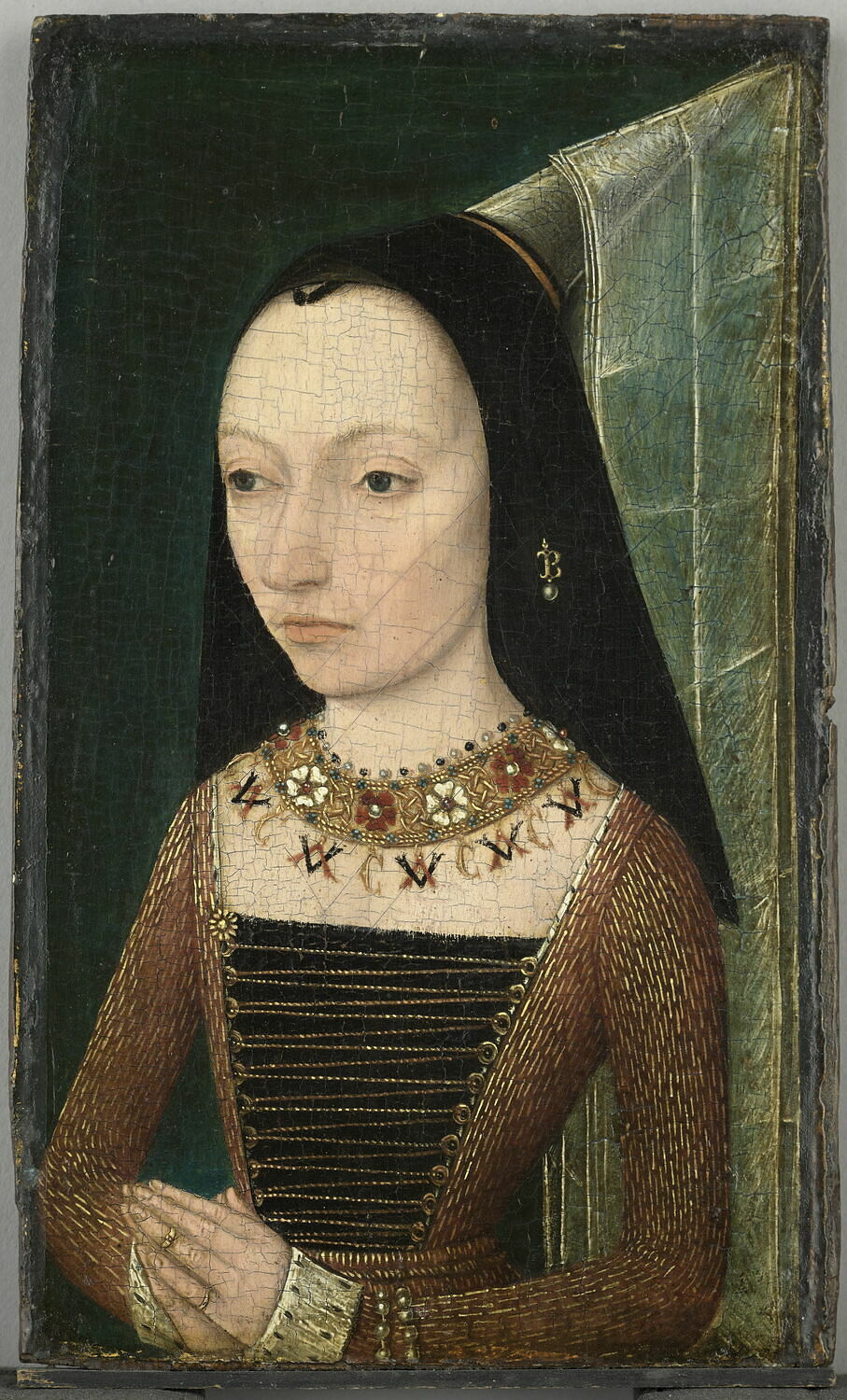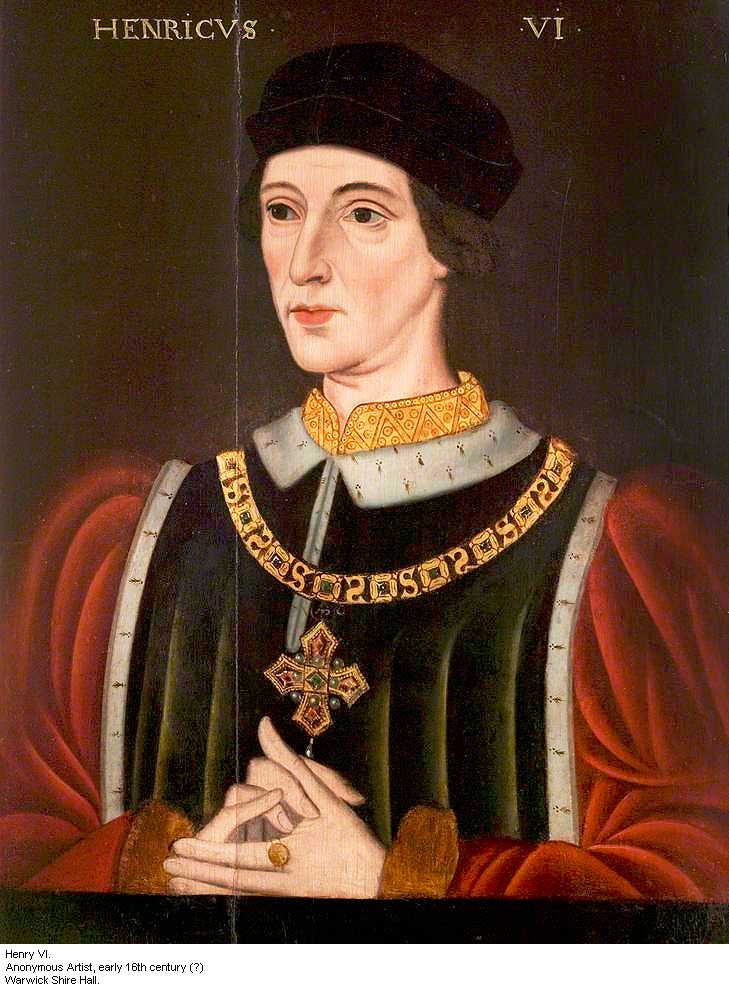The 15th Century was the final period of the medieval era and fashions in England at the time reflected this. The English Renaissance occurred in the 16th Century but England's 1400s fashion was influenced by Europeans due to the nearby flamboyant Burgundian court.
The Duchy of Burgundy at it's height stretched from the North Sea shores of Flanders to the peaks of the Swiss Alps and gave access to trading routes where Italian and Eastern fabrics were traded to English wool merchants via the ports of Bruges and Antwerp.
Wool was a popular fabric due to it's versatility from rough undyed cloth to fine, dense broadcloth with a velvety nap. The English economy thrived on high quality broadcloth, being exported throughout Europe with dyes bringing rich colours of reds, greens, golds, and blues.
 |
| Margaret of Anjou wearing a white ermine fur-lined gown |
Linen and hemp were also popular but Asian silk extravagance of silver-gilded wefts and stately floral embroidered motifs were worn by the richest of nobles. Furs would often be worn by the nobility with linings of dark brown sable or marten and white ermine furs.
NOBLE WOMEN
Women in the 15th century would often be dressed in a long gown with a low cut V-neck that would reveal a decorated square-necked kirtle and below this would be a linen chemise worn next to the skin. Gown skirts would often be carried looped-up to allow walking and were high-waisted, tightened with a belt. The heavily ornamented sleeves could be detached from the gown whilst the lining of the sleeve cuffs would match that of of the fur or velvet-trimmed neckline.
 |
| Elizabeth Woodville's matching cuffs, neckline and truncated English hennin |
Various overgowns were worn but the most popular was the houppelande with the snug sleeves at the wrist creating a full "bag" sleeve that was sometimes slashed in the front to reveal the lower arm. The sideless surcoat of the 14th century had since been retired to royal ceremonial costume with it being confined to special occasions and royal portraits.
Head-dresses had developed from simple hairnets into ornate pieces with the hair pulled back to accentuate their designs. A heart-shape padded roll, or a veil was worn on the headpiece and wire frames exaggerated the veils that draped from the back or front of the headdress.
 |
| Margaret of York, Richard III's sister and Duchess of Burgundy, wears a veiled hennin |
The most extravagant headdress was the cone-shaped hennin that was adorned with a fabric-covered wire frame and topped with a floating veil. The fall of the Burgundian empire in the 1480s saw noble head-dresses resemble those of the merchant classes with smaller, more convenient, and less picturesque designs.
Social status was also shown in jewellery as previous laws restricted commoners from having precious stones, pearls and excess amounts of gold and silver. Noble women wore intricate and elaborately decorated rings, necklaces, brooches, lockets, belts and purses. Their personal possessions such as combs and book-covers were also be jewelled. Much of the jewels were imported and used as security against loans.
The noble woman's attire was complete with laced ankle-boots, often lined with fur and these were later modified with the pointed toe of poulaines.
NOBLE MEN
A nobleman's wardrobe wasn't as varied but was just as orate as women's as they wore a shirt, doublet, hose, and an overgown robe. The linen shirt sleeves were often pulled through the slashes of the covering doublet to make embroided puffs that were embroided at the elbow and back of the arm.
 |
| Henry VI wearing a green doublet and black hat |
A doublet was worn over the shirt and they would be tightly fitted with either belts or tailored designs hugging the waist, giving the effect of a short skirt below. The doublet would often be elaborately pleated, especially at the back. The solid torso design was contrasted with long attenuated legs and feet with extremely tight wool hose and long pointed poulaine shoes or thigh-boots.
 |
| Sharp pointed toe poulaines worn in Burgudy |
The loose linen undergarment breeches were worn by men across all social classes and were held up by a belt that would also tighten the hose. As doublets became shorter, the hose would reach over the hips and up to the the waist. The two hose legs were sewn together into a single garment with a pouch or flap covering the front opening and would later evolve into the codpiece.
 |
| Richard III wearing a golden houppelande, chain collar and cap badge |
Noblemen would wear a houppelande over their doublets with padded shoulders and full sleeves. The houppelande was often lined with fur as the hem and sleeves were cut into scallops. The wrist-length sleeves were full, forming a bag or sack sleeve, or were worn off the arm, hanging ornamentally behind. Cloaks or mantles were worn during ceremonies and in bad weather with a fastened brooch on one shoulder.
Men of all social classes covered their heads in the early 1400s with a hood and frequently wore it around the neck as a cowl or twisted it into a chaperon. Hats soon developed and varied from tall-crowned small brim hats to low-crowned, wider brims that were pulled in front into a point. These hats would be adorned with ornate cap badges and noblemen would also wear jewels on rings and large chain collars. The hats would cover hair usually in a bowl-cut style, with the hair shaved at the back of the neck but the hair would later be grown to shoulder length.
English commoners wore plainer clothes compared to the nobility due to cost and greater practicality. Women spun wool into cloth for their family's garments with them wearing long gowns covered by sleeveless tunics and wimples over their hair. A wimple was either a square or circular piece of material that was draped over the head to the shoulders and held in place by a band around the brow.
 |
| Hay is gathered by barefoot women in long-sleeved smocks, Les Très Riches Heures du duc de Berry. |
Men were dressed in short shirts and drawers that were almost never laundered, but the linen underwear was regularly washed. Sheepskin cloaks and woolen hats were worn in winter and leather boots were covered with wood to keep the feet dry. Cloaks would be tied with a belt that contained a knife, work tools and purse.
Long woolen habits were worn by the holy order in emulation of Roman clothing. The habits indicated which order they belonged to with Benedictines wore black, Cistercians wore undyed and the Franciscans wore grey, like the Greyfriars who originally buried Richard III. St. Benedicts monk were allowed to wear linen coifs to keep their heads warm after their saint stated a monk's clothes should be plain but comfortable. The Poor Clare Sisters, an order of Franciscan nuns, however had to petition the Pope in order to be permitted to wear woolen socks.
 |
| Nuns with different lengths of scapula |
Nuns had two habits, two wimples and veils, a scapular for work, shoes and stockings. The extra habit allowed for washing and night-time wear. A nun's habit was tied around the waist with a cloth or leather belt and a scapula cloak was worn over the shoulders with an opening for the head. The front of the scapula was secured with a small piece of rectangular cloth that snapped the sides together and a wimple or veil was attached to the scapula. Some nuns would also wear a cross upon a chain around their necks









I happened upon this post as I was browsing google images for fashion in England in the 15th century, particularly nobility, so I can compare the visions in my mind to it. My 3 main branches of family lineage are through nobility and royalty in England and Scotland, Brittany, Normandy, and Norway. I have memories through my ancestors of royal court, wearing armor and jousting, hearing court music of late medieval or Renaissance times and remembering how to dance to it. I thought my 5 yr old, my 20 yr old recorded it. And yes, this is exactly how I pictured the clothing to look. I've searched youtube for the dance to this song I knew the dance to, but nothing. I know it as if I've danced it many times before. I decend from the house of Long who were knights throughout the medieval and Renaissance periods of England, acting as sheriffs, Barons, knights of the shire, and members of parliament. Coming from Normandy with William the Conqueror to conquer England in 1066. As did my Stuart ancestor Flaad FitzAlan from Brittany and my Osborne ancestor, Walter Fitz Osbern of Normandy. Through Stuart we decend directly from Mary Queen of Scots, James 1st, and Charles 1st. The Osbornes were appointed as Earls in Hartford.
ReplyDelete